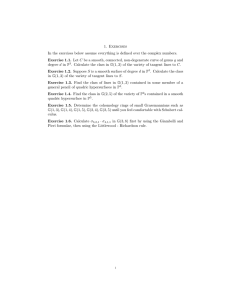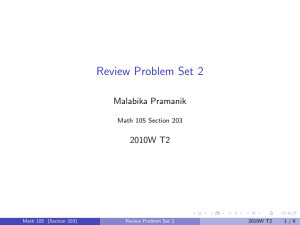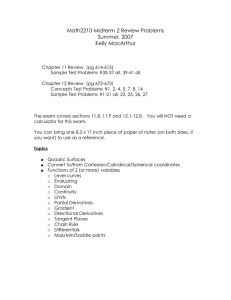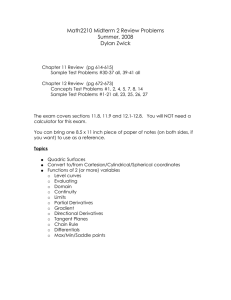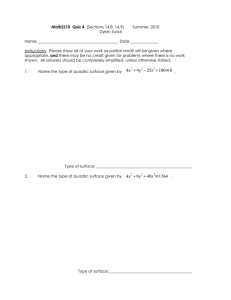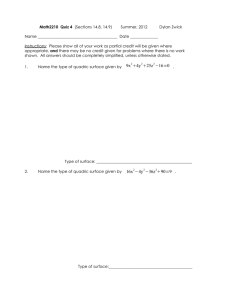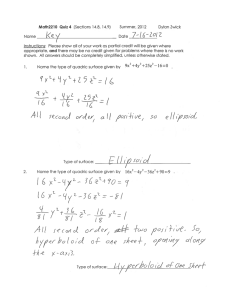Three-Dimensional Surface Recognition Based on Genetic Algorithms
advertisement
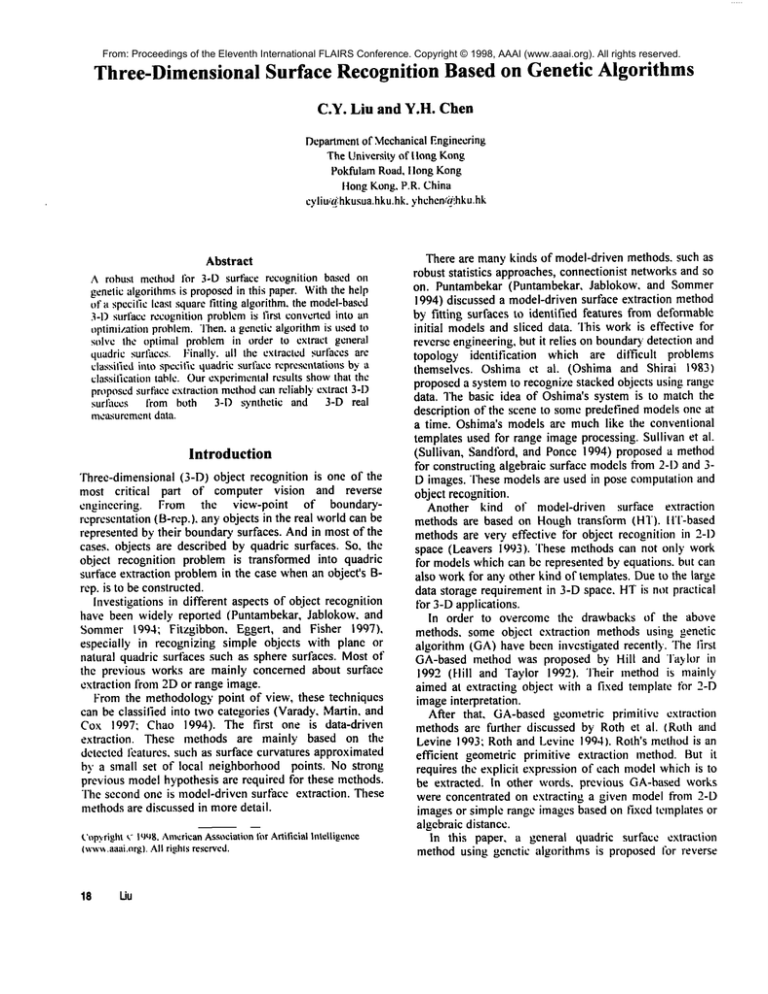
From: Proceedings of the Eleventh International FLAIRS Conference. Copyright © 1998, AAAI (www.aaai.org). All rights reserved.
Three-DimensionalSurface Recognition Based on Genetic Algorithms
C.Y. Liu and Y.H. Chen
Departmentof MechanicalEngineering
The University of 1longKong
PokfulamRoad, I long Kong
1tong Kong.P.R. China
cyliu~’~:hkusua.hku.hk,
yhchenr/’/!hku.hk
Abstract
A robust methodfor 3-D surface recognition based on
genetic algorithmsis proposedin this paper. Withthe help
of a specilic least squarefitting algorithm,the model-based
3-1) st,rfacc recognitionproblemis first convertedinto an
optimizationproblem.Then.a genetic algorithmis usedto
solve the optimal problemin order to extract general
quadricsurfaces. Finally. all the extracted .~urlhees arc
das.~ificdinto specific quadriesurt:acc represeutationsby a
classilicatio,1 table. Ourexperimental
results showthat the
proposedsurface extractionmethodcanreliably extract 3-I)
surfaces l’rom both 3-1) synthetic and 3-D real
measurement
data.
Introduction
Three-dimensional (3-D) object recognition is one of the
most critical
part of computer vision and reverse
engineering.
From the view-point
of boundaryrepresentation (B-rep.). any objects in the real worldcan
represented by their boundarysurfaces. Andin most of the
cases, objects are described by quadric surfaces. So, the
ob.jecl recognition problem is transformed into quadric
surf:ace extraction problemin the case whenan object’s Brep. is to be constructed.
Investigations in different aspects of object recognition
have been widely reported (Puntambekar, Jablokow. and
Sommer1994; Fitzgibbon, Eggert, and Fisher 1997),
especially in recognizing simple objects with plane or
natural quadric surthces such as sphere surfaces. Most of
the previous works are mainly concerned about surface
extraction fronl 2Dor range image.
From the methodologypoint of view, these techniques
can be classil]ed into two categories (Varady, Martin, and
Cox 1997: Chao 1994). The first one is data-driven
extraction.
These methods are mainly based on the
detected features, such as surface curvatures approximated
by a small set of local neighborhood points. No strong
previous modelhypothesis are required for these methods.
The second one is model-driven surthcc extraction. These
nlethods are discussed in moredetail.
L’t~p.x.right
~ I~JtJS.Am~:rican
Assoeialion
thr ArtificialInte|ligcnc¢
(ww~.aaai.org).
Allrighlsreserved.
18 Liu
There are manykinds of model-driven methods, such as
robust statistics approaches, connectionist networksand so
on. Puntambekar (Puntambekar, Jablokow, and Sommer
1994) discussed a model-drivensurface extraction method
by fitting surfaces to identified features from deformable
initial modelsand sliced data. This workis effective for
reverse engineering, but it relies on boundarydetection and
topology identification which are difficult problems
themselves. Oshima ctal. (Oshima and Shirai 1983)
proposed a system to recognize stacked objects using range
data. The basic idea of Oshima’ssystem is to match the
description of the scene to somepredefined modelsone at
a time. Oshima’s models are muchlike the conventional
templates used for range image processing. Sullivan et al.
(Sullivan, Sandibrd, and Ponce 1994) proposed a method
for constructing algebraic surface modelsfrom 2-D and 3D images. These models are used in pose computation and
object recognition.
Another kind of model-driven surface extraction
methods are based on Houghtransform (HI). liT-based
methodsare very effective for object recognition in 2-1)
space (Leavers 1993). These methods can not only work
for modelswhich can be represented by equations, but can
also workfor any other kind of templates. Dueto the large
data storage requirement in 3-D space, HI" is not practical
tar 3-D applications.
In order to overcome the drawbacks of the above
methods, some object extraction methods using genetic
algorithm (GA)have been investigated recently. The Iirst
GA-basedmethod was proposed by Hill and ’l’a).lor in
1992 (Hill and Taylor 1992). Their method is mainly
aimed at extracting object with a fixed template for 2-D
imageinterpretation.
After that, GA-basedgeometric primitive extraction
methods are further discussed by Roth et al. (Ruth and
Levine 1993: Roth and Levine 1994). Roth’s methodis an
efficient geometric primitive extraction method. But it
requires the explicit expression of each modelwhichis to
be extracted. In other words, previous GA-hased works
were concentrated on extracting a given model from 2-[)
images or simple range images based on fixed templates or
algebraic distance.
In this paper, a general quadric surface extraction
method using genetic algorithms is proposed Ibr reverse
engineering application. Instead of using fixed templates or
algebraic distance, the proposed method uses the more
flexible and reliable pseudo geometric distance. Further
more, the proposed method is capable of recognizing all
quadric surfaces including planes based on a single quadric
surface expression.
Motivations
and Definitions
It has recently been shown that extracting the best
geometric primitive from a given set of geometric data is
equivalent to finding the optimumvalue of a cost function
(Roth and Levine 1994). Thus the goal of any extraction
algorithm is to find the global optimumfrom amongmany
local optima. A genetic algorithm is an optimization
approach based on the evolutionary metaphor. It has been
shown to consistently outperform both gradient methods
and randomsearch in solving optimization problems if the
cost function is noisy, multidimensional and has multiple
local optima (Eiben, Raue, and Ruttkay 1995; Goldberg
1989; Manet al. 1997). So, in this paper, a GAis used to
find global optimumof a set of optimal modelsset up for
quadric surface extraction.
Since GAshave rarely been used in reverse engineering,
some definitions and important operations of GAsare
briefly described in the following.
¯ Chromosome:
the code of a point in the variable space is
called a chromosome.It is often a binary code in a
conventional GA. In recent research, other encoding
methods have been proposed. For example, a solution
x=(xt, x,_ ..... Xr) can be encodedas a string of genes to
form a chromosomerepresenting an individual.
¯ Population: a set of N chromosomes(or say individual
in somecases) is called a population. Here N is the size
of the current population and it is a predefined constant
before evolution.
¯ Crossover: the operation that two parent chromosomes
are combined in some way to generate two new
individuals or children.
¯ Mutation: the operation of selecting a gene randomlyfor
a given individual and mutatingthe allele for that gene.
¯ Cost function: the objective function in an optimal
research.
At the beginning of a GA,data points in the searching
space are encoded to form a set of individuals. Then, an
initial population can be created by certain selecting
procedures, such as randomselection.
After that, the evolution cycles begin. In each evolution
cycle, a pair of parents are selected from the current
population to generate children by someoperators such as
crossover and mutation. Thoughthere are manydifferent
kinds of crossover and mutation operators, we use the
uniform crossover and mutation operators in this research.
If the cost of the new child is greater than the minimum
cost individual in the current generation, the minimum
cost
individual is replaced by the new child to keep the
generation size invariant. The procedures continue until
costs are high enoughfor all individuals. The individual
with maximum
cost is the solution of the optimal problem.
Let xi be the ith measurementdata point, and D=lxi,
i=l,2,...,n} be the whole set of measurementdata points.
Someof the important definitions used for our algorithm
are given below:
¯ General QuadricSurfaces (GQS):all of the possible first
and second degree surfaces in 3-D are called GQS.A
specific surface in GQSis denoted as S. The equation of
GQSis represented by Equation( I ).
f(x)=a
~
~2
I. +a2y- +a3zaTx+agy+tz,~z+ato
+a4xy+asxz+th,.~-+
= 0
(I)
¯ Algebraic Distance (AD):the absolute value of/(x) for
data point x is defined as the algebraic distance between
a point x and S.
¯ Pseudo Geometric Distance (PGD): the minimum
Euclidean distance betweena point x and S along the x,
y and z axes respectively.
¯ Generalized Minimal Subset (GMS): each subset of
data points in D is called a GMS.The ith GMSis
denoted as D
i.
A GMSis the minimumdata points required for the
solution of Equation(I). In fact, l0 parametersin Equation
(I) must be determined, but there are only 9 of them are
free by addinga extra constrain equation.
In our algorithm, a chromosomestring is presented by
the indices of its memberpoints for effective computation.
For example, if a possible GMSis DiO:-{P~,PL,- P~, P_-4P.-s, P~, P~7, Ps, P~}, the correspondingchromosome
string
will be represented as |1, 12, 3.24, 25, 6, 17, 8, 39}. In
this paper, we will not distinguish between a GMSand its
corresponding chromosomestring.
A conventional minimal subset is the smallest numberof
points necessary to define a unique instance of a geometric
primitive, and the primitive passes through the points in
the minimal subset exactly without error of fit (Roth and
Levine 1994). A GMSis different from the conventional
minimal subset in that a GMSmaynot consist any part of
any quadric surfaces, because someGMSscan not be fitted
successfully by the least-square fitting method.
¯ Cost Function ofa GMS(CFG): the function that counts
the numberof points within a small PGDto the quadric
surface fitted by the current GMS.
The CFGofa GMSDi is denoted as h(Di). For example,
ifthe current chromosomeis Dio={2, 4, 19. I. 33.21.23,
8, 9} and there are 14 points within a small PGDto the
current fitted surface of Dio, the value of cost fimction
(abbreviatedas cost in the later parts of this paper) will
14, that is, h(Dio)= 14.
¯ Minimumcost of a population (MCP): the minimum
value of CFGin a population is called the MCPof this
population.
AI Applications 19
Algorithm
Our GA-based quadric surface extracting algorithm is
composed of two main components. The first one is
quadric surface parameter finding by least square fitting
(Marshall and Martin 1992) for all GMS.From the view
point of feature extraction, this componentcan be taken as
data-driven. For the second one, a modified GAworking
on GMSis used to extract the surface that has the
maximum
CFG.This componentrelies mainly on the fitted
surface parameters, so it can be taken as model-driven.
Di
By comparingcoefficients of Equation(4) and {5). it is
not difficult to get Bi, Ci and Di.
Then, the minimization of X:, with constraint as shown
in Equation (4) can be solved by using the method
Lagrangian multipliers (Marshall and Martin 1992). The
problem reduces to finding the minimum 3. and
corresponding vector p such that
Mp- pl=O.
Quadric Surface Parameter Calculation
by
In out" research, the least square fitting algorithm tbr
quadric surfaces is based on Lagrangian multipliers and
matrix eigenvalue decomposition (Marshall and Martin
1992: Pettofrezzo and l,acatena 1970). Andbecause it is
linear problem,no iterative methodis required.
A general quadric surface shownin Equation (I) can
expressedalternatively,
xrAx ~- xTv + d = 0
(2)
Matrix A gives in/brmation about the geometric tbrm of
the quadric surface.
The natural geometric interpretation of error in least
squares fitting is the distance of each point to the surface.
However, in the case of quadric surfaces, using such a
measure would cause the mathematics of the approximation to becomevery awkward.Instead, Martshall et al.
(Marshall and Martin 1992) suggested to use quantities
similar to those used in the case of planes to keep the
approximationsimple. Thusthe error in the fit of the set of
points {xi~, i-,l ..... n. to a quadric surface is defined by
using Equation (2)
Z:: ~(x?Ax,+ X,V+ d)-"
(3)
Unlike plane fitting, there are 10 parametersfor quadric
surface fitting. As only 9 parameters are independent.
there must exist a natural geometric constraint. A known
methodfor choosing constraints which are invariant with
respect to geometrictransformations is
h
(4)
Let p~(al, a ...... ato)T, Pt-(al. a: ..... a~,)r, pz=(a~.....
a~,,) r, then, Equation(4) can be rewritten
IP,i--I
(5)
BecauseEquation (3) is a quadratic function of the
components
of p, it canbe written as
Z; -- ~p"M,p= prMp
(6)
where M~M
i. and the summationis over all data points
xi-(xi ¯ Yi. -i). Miis the symmetricmatrix
20
Liu
(8)
Since p=(pt, P2), the systemof Equation(8) can be split
into twoparts
Lagrangian Multipliers
Tr(AA’)= Za~ = I
171
Bpt+Cp,-;’,pl:0
CTp~+Dp2-0
(9)
t I0)
According to the Lagrangian multipliers method, the
minimum
value of ~.. say ?~,,,.,. in Equation(q) is the lowest
eigenvalue of the matrix B-CD~C~ . The unit eigenvector
correspondingto ),., .... is the solution tbr p~. Kno~.ingp~.
the solution for p,_ can be obtained from Equation (10)
solving the linear systemof equations
Dp2 -crpl
(I I)
Quadric Surface Extraction by a GA
The first step is the creation of an initial popttlation. The
initial population is randomly selected from the data
points. If there are totally N data points, the maximum
size
of the population can be t’":. In order to accelerate
computation,the populationsize is set to N--9.
In the evaluation process, Equation(I) is fitted to all
GMSby the l.agrangian multipliers methodas described in
the abovesection. For each successful fitting, its C’[-Gis
accumulatedby checking each data point’s PGI).
The tbllowing important step is to generate new
generations by crossover and mutation. The parent (iMSs
are randomly selected to generate two children (iMSs by
crossover. If the cost of either one ot" the lwo newchildren
GMSsis greater than the MCPof the population, the
corresponding GMSis taken as a new memberof the new
population, and the GMSwhich has the MCPis removed
fromthe current population: If the first child GMS’scost is
less than the MCP
of the current population, it is mutated
with another randomly selected (]MS. l’l~e uniform
crossover and mutation operators which switch each gene
(element of GMS)according to a unilbrm probability
distribution are used in our research.
The terminating condition is set to be either a threshold
(.;; for MCPor the maximumnumber of iterations.
Accordingto our experimental experience, t ;. should bc a
positive integer greater than 10. Whenever a run
terminates, the fitted surface which has the maximum
CFG
is taken as the current extracted surface.
After that, all points within a small PGD
threshold ,~, are
deleted from the measurement data sets, and the above
procedures continue to run on the remaining data points
until no moresurfaces can be extracted.
Finally, every extracted general quadric surface is
classified into a special quadric surface according to a
classification table given by Levin (Levin 1976).
Experimental
Results
Two examples are demonstrated with the proposed
method. The first one uses simple synthetic points to
demonstrate the recognition of a sphere surface. The
second exampleshowssurface extraction from a real set of
data points.
Quadric Surface Extraction from 3-D Synthetic
Data Points
A set of synthetic data points are generated by selecting 30
points on a unit sphere whosecenter is at the origin, and 30
points on the XYplane as shownin Figure I.
Figure 2: Data points on a hair blower’s upper surface
Accordingto the classification table given in reference
(Levin 1976), this surface is classified as a hyperboloid
one sheet. All points on this surface are shownin Figure 3.
-" .r-. t - .. "
;,
::-:: ’-i’
":,..4=.....-:Figure 3: Data points on the first extracted surface
Figure 1: Synthetic points on a unit sphere and XYplane
Set the threshold value of MCPand PGDto C0=15and
6o=0.01respectively. After 118 iterations, a surface with
the followingequation is extracted.
x2 +O.995y2+O.998z2+O.OO2xy-O.O
16xz+0.019yz0.004x-0.005y-0.006z-0.991 =0
(12)
From Equation (12), all parameters can be used to
calculate the related variables for the classification table
given by Levin(Levin 1976). it is not difficult to showthat
the extracted surface is a sphere. Further more, the
extracted surface expression can easily be identified as a
unit sphere even by simply observe the parameters of
Equation(12). it also demonstratesthe effectiveness of the
proposed method.
Quadric Surface Extraction from 3-D
Measurement Data Points
A set of real data points digitized from a hair blower’s
upper surface are examined by our algorithm. The data
points are digitized
by a Mitutoyo BLNI22 CMMin
automatic line-by-line scan mode. The measurementpoints
are shownin Figure 2.
After running the algorithm, 6 surfaces are extracted.
For example, in the first run, a surface expression is
extracted after 357 iterations. The extracted surface has
the following equation.
x2-0.004y2+1.065z2-0.012xy-0.01xz-O.O32yz90.18x+3.08y- 1.22z- 119.13=0
(13)
With the remaining points after first run, the above
procedures are executed again. Another quadric surface is
extracted after 572iterations. Its equation is shownbelow.
x2+ 171 .By~- 116.4~+1.4x~-3.0xz-5.9yz451.8x-31835.0y-534.9z+1457649.4=O
(14)
In the same way, the second extracted surface is
classified to be an ellipsoid. Andall points on this surface
are shownin Figure 4.
Figure 4: Data points on the second extracted surface
The above procedure is repeated until not enoughpoints
(less than 2C0=30in this experiment) are left in the
remaining measurementdata set.
Conclusions
andDiscussions
Fromthe above analysis and experiments, it can be seen
that the proposed method is very effective for quadric
surfaces extraction. Because most mechanical parts are
AI Applications 21
designed by planes and quadric surfaces, this methodcan
work well for the majority of reverse engineering
applications. Take ellipsoid extraction for example, no
matter what the size is and where the three main axis’s
directionsare, it canbe extractedin just onerun.
Anothermerit of the proposed methodis that it does not
rely on surface segmentation which is a very difficult
problemitself. In fact, the segmentationproblemis solved
at the same time as surfaces are extracted because
boundarycurves can be calculated by surface intersections.
Because of the combinedfeatures of both data-driven and
model-driven, the proposed method is more flexible and
robust in surface extraction.
Anotherfeature of our algorithm is that it uses pseudo
geometric distance in stead of algebraic distance for
judging if a point is close enoughto the fitted surface. The
pseudo geometric distance has an intrinsic geometric
significance andalso can be easily calculated.
Further worksare investigated aimingat accelerating the
speed of the algorithm. One of the most important work to
be done is the data reduction whichcan not only reduce the
numberof data points, but also keep the important points
with characteristics of surface properties. These points
often have extreme curvature change, and must be kept
after data reduction.
References
Puntambekar, N. V.: Jablokow, A. G.: and SommerIlk H
J. 1994. Unified Review of 3D Model Generation for
Reverse Engineering. ComputerIntegrated Mamf/bcturing
3):stems 7(4):259-268.
Fitzgibbon, A. W.; Eggert, D. W., and Fisher, R. B. 1997.
High-Level CADModel Acquisition from Range Images.
Computer-Aided Design 29(4):321-330.
Varady, T.; Martin, R. R.: and Cox, J. 1997. Reverse
Engineering of Geometric Models - An Introduction.
Computer-Aided Design 29(4):255-268.
Chao, C. H. 1994. Artificial Neural Networks and ModelBased Recognition of Three-Dimensional Objects from
Two-Dimensional Images. Ph.D. Diss.. University of
Cincinnati.
Oshima. M.: and Shirai, Y. 1983. Object Recognition
Using Three-Dimensional Information. IEEE Transactions
on Pattern Analysis and Machine huelligence 5(4):353361.
Sullivan, S.; Sandlbrd, L.: and Ponce, J. 1994. Using
Geometric Distance Fits for 3-D Object Modeling and
Recognition. IEEETransactions on Pattern ,4nalysis atut
MachineIntelligence 16( 12): I 183- I 196.
Leavers, V. F. lOLl. Which llough transtbrm?. CVGIP:
ImageLblderst,mding58( I ): 1-22.
tlill,
A.; and Taylor, C. J. 1992. Model-Based Image
Interpretation Using Genetic Algorithms. Imageand I’ision
( "omputing10(5):295-300.
Roth. G.; and Levine, M. D. 1993. Extracting Geometric
Primitives. C’I’GIP: hnageUnder.~’tanding58(1):1-22.
Roth, G.; and Levine, M. D. 1994. Geometric Primitive
Uu
Extraction Using a Genetic Algorithm. IEEE Transactions
on Pattern Analysis anti Machineh~telligence 16(9):901905.
Eiben, A. E.; Raue, P. E.: and Ruttkay, Z. 1995. Ilow to
Apply Genetic Algorithms to Constrained Problems. In
Practical Handbookof Genetic Algorithms: Applications,
Volume1,307-366. Florida, USA:CRCPress, Inc.
Goldberg, D. E. 1989. Genetic’ Algorithm in Search.
Optimization and Machine Learning. Reading, Mass.:
Addison-Wesley.
Man, K. F.; Tang, K. S.: KwongS.; and Halang, W. A.
1997. Genetic Algorithms ]br Control and S(gnal
Processing. Great Britain: Springer-Verlag I,ondon
Limited.
Marshall, A. D.: and Martin, R. R. 1992. (’omputerl’ision.
Modelsand blspection. Singapore: WorldScientific.
Levin, J. A. 1976. Parametric Algorithm for Drawing
Pictures of Solid Objects Composedof Quadric Surfaces.
Graphics and ImageProcessing 19( i 0):555-563.
Pettofrezzo, A. J.; and Lacatena, M. M. 1970. ,4nalytic
Geometrrwith l’ectors. Scott:Foresman and Company.
